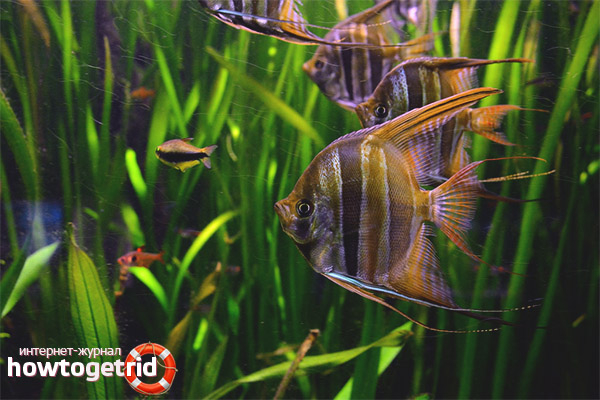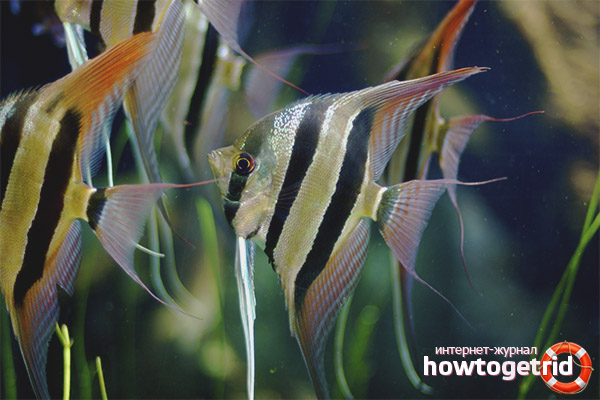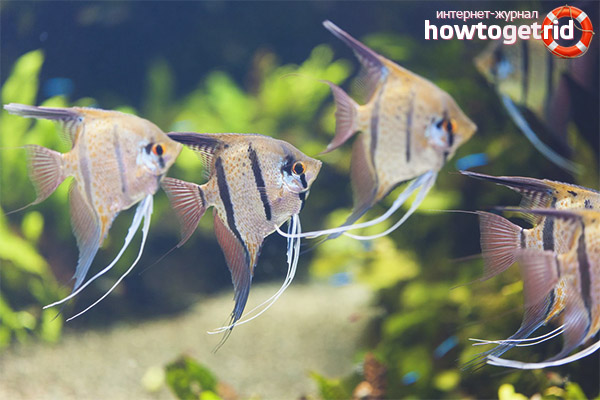The content of the article
Under the scalar refers to a hunting type of fish, which is distinguished by its voracity and aggressiveness. Usually she hunts for fry of foreign fish, some owners even faced situations when scalars ate their eggs. Despite such habits, fish have some features, including external data and unpretentiousness in the content. Today we will analyze them step by step.
Description
- For the first time, the fish of the represented group were described by Schulz in the distant 1800s. The fish were originally bred in the United States of America, then brought to Europe for further study.
- Breeders who sell scalar are convinced of the absolute similarity of aquarium pets with those that live in nature. But due to the extensive breeding activity, fish have changed a lot.
- Angelfish prefer slow-flowing water sources. Their homeland is the dangerous and limitless Amazon, as well as tributaries. You can find this family in vivo in South America.
- According to their characteristics, representatives of the family live in reservoirs with a small volume of vegetation. Eat fry, as well as plants and invertebrates. To date, 3 types are distinguished: leopold angelfish, altum and traditional (ordinary).
- It is difficult to say for sure which kind of fish is most common. Many crosses were made, which is why scalars have changed their appearance a thousand times. As for the duration of existence, they live up to 15 years.
- Fishes living in natural conditions are as close as possible in color to the natural biotope. They are silver with dark stripes on the body. The format of the body is flattened, the upper fin is sharp, the head is triangular.
- The tail can be in the form of thin rays, which helps aquatic representatives to camouflage among the roots and vegetation. Partly for this reason, in wild individuals, the color is an accumulation of dark stripes. According to individual characteristics, this family of fish is omnivorous. Angelfish await small fish and invertebrates, after which they attack them.
- It is difficult to identify for sure which sex the individual is in front of you, if the fish have not yet reached adulthood. Young animals cannot be studied by sexual dimorphism. However, even adults are sometimes difficult to distinguish. This is usually done when spawning begins. The female abdominal area is rounded, the ovipositor takes the form of a cone.
Temperament and behavior
- If you plan to acquire scalars, you must not only create the conditions for their comfortable existence, but also study the behavior in the aquarium environment. Without this, you can hardly understand your pets and satisfy their needs. To begin with, the number of individuals planted in one tank should be even.
- These water representatives belong to the pack categories. Therefore, the content of the whole family is considered an ideal option. Thanks to this distinction, the fish will independently choose a mate for themselves, and also establish a hierarchy in which the most powerful members of the family will lead a whole flock.
- Natural representatives belong to aggressive species. Of course, these are also found in the aquarium. But if scalars grow to medium size, they will not be angry with themselves. This will happen, perhaps, in the struggle for territorial ownership. But aggression can be ruled out by choosing a larger aquarium so that there is enough space for everyone.
- Fishes will begin to share the water between themselves, because they want to swim and hide in the thicket.Therefore, the ratio of liquid to vegetation should be moderate. Leave a place for maneuvers to the scalar, but at the same time do not keep the aquarium empty (without snags, stones, etc.).
- Scalaria belong to the cichlid family. Because of this feature, this group has a humiliating feature - pets beat weak aquatic representatives, gnaw fins and eat their fry. You can’t plant this category for those who cannot stand up for themselves.
- Pets will get along with the fish that usually live in the middle and lower sections of the body of water. As an excellent neighborhood, usually choose catfish, gourami, macro pods, etc. It is forbidden to plant guppies, golden fish, cardinals, neons, viviparous categories.
Feeding
- We already mentioned that these members of the family eat everything. They prefer to feast on any food. The main rule is that food should be of good quality. As a live feed, they choose a tubifex, artemia, bloodworm, and coronet.
- It should be remembered forever that they have no sense of proportion when it comes to food. They can eat constantly and in large quantities. Therefore, no matter how much the fish ask, do not overfeed them.
- Moths are given with extreme caution, not more than 1 time per week. It is better to abandon it altogether, replace it with another similar food. Because these fish have poor intestinal motility, disorders immediately begin.
- To date, many feeds created for scalars have been developed. Give preference to them. It is safe and relatively profitable. If you notice that the fish feed on delicate plants, give them spirulina supplements as a top dressing.
Content
- It is difficult to say for sure whether the content of this family is allowed for beginners who have absolutely no experience in aquariums. Fish can be aggressive towards smaller inhabitants; the neighborhood is chosen with great care. Plus, they need a large body of water, not every beginner will buy such an aquarium. Therefore, think for yourself, otherwise the care is simple.
- Under the scalar is understood to be a fairly fastidious fish, which, provided all conditions are met, will live 10 years. Since aquatic inhabitants have a strange body shape, an aquarium with high sides is required. As for the volume of water, about 100 liters are allocated per individual. water. If you plan to have 2 scalars, then purchase a 200 liter tank. The advantage of a large home is that parents are less nervous and do not eat eggs.
- These fish are quite thermophilic. They prefer to dwell in water with a temperature regime of 25-28 degrees. By their natural characteristics, they live in a soft and acidified environment. But they can quickly adapt. If we talk about the decor, scalars need a place to swim. Therefore, all driftwood, grottoes, cobblestones and other attributes are set strictly along the edges.
- The presented family of fish is relatively careful about vegetation, but can nibble tender thickets (for example, eleocharis or moss). But if you give your pets plant foods and supplements with spirulina, this will not happen. Weekly 20-25% of the fluid is drained, a new one is poured instead.
Compatibility
- The considered individuals are suitable for living in a "hostel". However, do not lose sight of the fact that the presented fish belong to cichlids. Therefore, often scalars are aggressive towards small inhabitants of the aquarium.
- Keep in mind that these individuals will constantly hunt shrimp and fry. Angelfish are good hunters, and they are also insatiable. The young of the presented individuals at first will stay together all the time. As soon as individuals reach puberty, they are divided into pairs.
- In addition, upon reaching puberty, scalars become more aggressive and territorial.However, it is worth noting the fact that the fish are timid to sudden movements. The same reaction occurs when light is turned on and to different sounds. It is recommended that these cichlids be kept with large or medium-sized individuals.
- Try not to start small fish in the general aquarium. They will not last long. Angelfish soon will simply eat them. Breeders do not recommend hooking up any kind of barbs. Otherwise, individuals will constantly conflict. Fiery barbs eat scalar fins in a short period of time.
- In the same way, black barbs, tetragonopterus, denisonioni, and thorns can do with scalars. The considered individuals are best kept with mollies, swordsmen, and pecilli. Often, scalars get along with guppies. Only in this case do not forget to transplant fry. In addition, gouras of various species can be hooked.
Breeding
- During puberty, the individuals in question form a monogamous stable pair. The only problem is that after spawning it is very difficult to keep eggs. Females typically spawn on vertical surfaces. Often in their role are flat sheets, driftwood and glass aquarium.
- To reproduce as efficiently as possible, special devices should be placed in the aquarium. To do this, you can take various cones, a piece of ceramic or plastic pipe. Like all types of cichlids, scalars take good care of their offspring. During spawning, parents carefully look after caviar.
- Such care lasts exactly until the fry are born. Do not forget that scalars themselves choose their mate. Therefore, for breeding it is best to buy several individuals. The fish themselves will figure it out and find a half for themselves. If you buy two heterosexual fish, they may not like each other.
- Do not lose sight of the moment when the couple will prepare for spawning. Otherwise, the whole caviar may disappear or it will be eaten. To understand how scalars prepare for spawning, it is worth watching them for several days. They will stick together all the time. In addition, they will allocate a corner for themselves and will drive out the other inhabitants of the aquarium.
- Individuals reach puberty at the age of 8 to 12 months. In this case, spawning in fish can occur almost every 10 days, if you take eggs from angelfish. Spawning in individuals begins with the fact that they are looking for a secluded place for themselves. They thoroughly clean and prepare it.
- After that, the female proceeds to throw eggs in the form of a chain. The male, in turn, immediately begins to fertilize her. The procedure can last quite a long time. The female is able to bring up to several hundred eggs. It is worth knowing that the eggs of individuals are light and rather large.
- After this, the couple begins to carefully look after the future offspring. Fish constantly fan their eggs. Also, scalars are eaten by unfertilized or dead eggs. After only a few days, the fry begin to hatch into the light. At this time, the offspring eats from the yolk sac.
- It is worth noting an interesting fact that the larvae begin to hatch into the light, while the eggs still remain attached to the surface. The offspring are not yet able to eat another food, for this they have a yolk bladder. It was mentioned earlier. Only a week later, the young growth begins to swim.
- By this time, the larvae develop into fry. It is recommended to feed offspring with naupilya brine shrimp. They also eat excellent special food for fry. According to the breeders, the first option is still considered the optimal food. At the same time, young growth begins to grow better and practically does not get sick.
- Fry is recommended to feed up to 4 times a day. In this case, food is better to pour portionwise. Young growth should be fed for several minutes.Do not forget about maintaining cleanliness in the aquarium and the freshness of water.
Angelfish are cichlids. At the time of puberty, individuals become quite aggressive and territorial. Therefore, do not hook small or too calm fish to them. Treat the selection of neighbors with all responsibility.
Video: aquarium fish angelfish













Submit